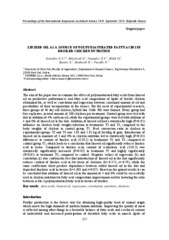| dc.description.abstract | The aim of the paper was to examine the effect of polyunsaturated fatty acids from linseed oil on productive performances and fatty acid composition of lipids of broiler chicken abdominal fat, as well as correlation and regression between consumed amount of oil and possibilities of their incorporation in the tissues. For the need of experimental research, three groups of 40 day old chicken, hybrid line Cobb 500 were formed. Every group had five replicates, in total amount of 200 chickens per treatment. Control group were fed with diet in addition of 4% soybean oil, while the experimental groups were fed with addition of 4 and 8% of linseed oil in the diet. Addition of linseed oil had a statistically high (P<0.01) influence on chicken body weight reduction in treatments T2 and T3, compared to the body weights of chicken in control group T1. Feed conversion ratio in chicken in experimental groups T2 and T3 was 1.84 and 1.82 kg of feed/kg of gain. Introduction of linseed oil in amounts of 4 and 8% in chicken nutrition led to statistically high (P<0.01) differences in content of linoleic acid (C18:2) in treatments T2 and T3, compared to control group T1, which leads to a conclusion that linseed oil significantly reduces linoleic acid in tissue. Compared to linoleic acid, content of α-linolenic acid (C18:3) was statistically significantly increased (P<0.05) in treatment T2 and highly significantly (P<0.01) in treatment T3, compared to control. Negative values of regression (b) and correlation (r) also confirm the fact that introduction of linseed oil in the diet significantly reduces content of linoleic acid in fat tissue of chickens (b=-0.551; r=-0.79), while the same coefficients show positive dependence between added linseed oil in the diet and deposited linolenic acid in tissues (b=1.081 and r=0.87). Based on the gained results it can be concluded that addition of linseed oil in the amount of 4 and 8% could be successfully used in chicken nutrition for fatty acid composition improvement and for lowering the ratio between n-6/n-3 polyunsaturated fatty acid in tissues of broilers. | en |



